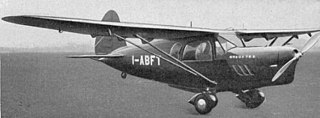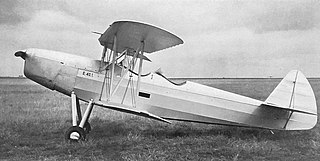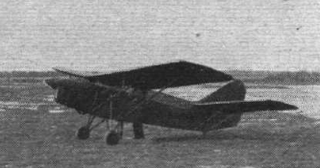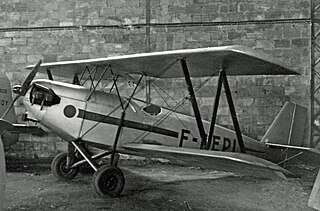
The Breda Ba.79S was a single-engine four-seat high-wing private aircraft built in Italy in the late 1930s. Only a few were produced.

The IAR-22 was a single engine basic trainer built in Romania in about 1934. It was a low-wing monoplane with two seats in tandem and a fixed conventional undercarriage.

The Praga E-40 was a single engine, two seat, biplane basic trainer, built in Czechoslovakia in the mid-1930s.
The Gardan GY-120 was a single engine, parasol wing ultralight seating two in tandem, designed and built in France in the 1980s. It did not go into production.

The Starck AS-57 is a single engine low wing monoplane seating two in side-by-side configuration. It was designed and built in France just after World War II; only ten were produced, one of which was still active in 2012.

The Tachihi R-53 was amongst the first aircraft built in Japan after the relaxation of the ban imposed at the end of World War II. It is a parasol-wing, two seat, training aircraft powered by a British engine. Only one was produced.

The Pander P-1 and P-2 were close to-identical single engine Dutch sports aircraft with tandem seats and a parasol wing, first flying in 1929. Only two were built.
The Koolhoven F.K.44 was a two-seat, single engine sport monoplane designed and built in the Netherlands in the early 1930s. It was built to order, but only one was completed.

The Koolhoven F.K.54 was a Dutch single-engine, three-seat touring aircraft with a retractable undercarriage. It flew shortly before the start of World War II and its development was abandoned after its first flight as attention turned to military aircraft.
The Gidrosamlet Che-24, 26 and 29 are closely related light flying boats designed and built in Russia from 2010.
The Aviator Shershen' is a Russian two seat biplane, sold in kit form. It first flew in 2005 and several variants have been produced, with a choice of engines.

The Leduc RL.21 was a single engine, single seat light aircraft built in the late 1950s in France. Designed to achieve high speeds from modest engine power, it set seven class records in the early 1960s.

The SFCA Lignel 20 was a French, single engine, low wing monoplane, one of a series of this type built by SFCA in the 1930s. It was capable of aerobatics but was primarily a racing aircraft.

The SFCA Taupin was a French tandem-wing aircraft, designed to provide a simple, stable and safe aircraft able to take-off and land in small spaces.
The Renard R.33 was a Belgian training aircraft with aerobatic capability. Two were flown in 1934 but no more were produced.
The Régnier 12 was a 1930s Belgian touring aircraft offering variants with different engines and seating plans. Only one was built.
The Hockaday Comet was a two-seat light civil aircraft, built in the United States before World War II but not flown until near the war's end. It failed to attract buyers and only one was completed.

The Charmier-Dupuy 10 was a French parasol-winged single seat light aircraft designed for low cost flying. The sole example was first flown in 1924. Over a long career, it was fitted with three different engines and remained on the French register until after World War II.
The Tachikawa KKY, full name Tachikawa Army Small and Light Ambulance Aircraft was designed to rescue injured or sick patients from places without established airfields. Following two earlier prototypes, 21 production examples were built between 1936 and 1940 and served in the Second Sino-Japanese War.

The SCAL FB.40 was a French, side-by-side seat biplane trainer chosen in 1938 for widespread use in the Aviation Populaire programme. The Second World War prevented large scale production but at least two were restored post-war, one becoming a familiar rally participant.












